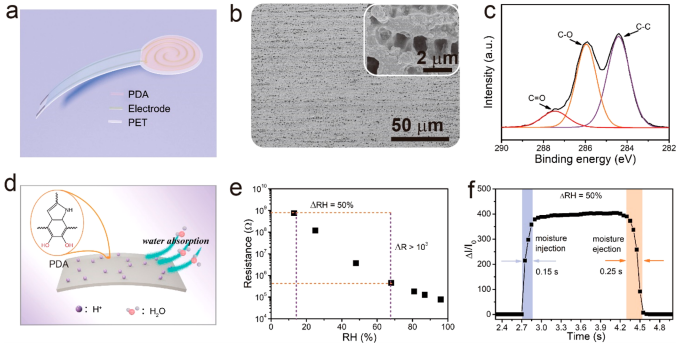文章专利

- 地址: 江苏省苏州市苏州工业园区若水路398号
- 邮箱: tzhang2009@sinano.ac.cn
- 电话: 86-512-62872706
- 传真: 0512-62603079
- 网址: http://nanosensor.sinano.ac.cn

Moisture-Driven Power Generation for Multifunctional Flexible Sensing Systems. Nano Lett.2019,July 26
Lianhui Li, Zhigang Chen, Mingming Hao, Shuqi Wang, Fuqin Sun, Zhigang Zhao,and Ting Zhang*

Abstract
Flexible self-powered multifunctional sensing systems provide a promising direction for the development of wearable electronics. Although increased efforts have been devoted to developing self-powered integrated devices, the development of flexible and adaptable sensing systems with miniaturized stable power supplies is highly desirable yet greatly challenging. Herein, an ambient moisture-induced self-powered wearable sensing system was fabricated by integrating a porous polydopamine layer with a hydroxy group gradient (called g-PDA) based moisture-enabled power generator and a flexible pressure sensor. Due to the large amount of gradient-distributed free cations (H+) and locally confined anions produced in wide electrode spaces during hydration of the thin porous g-PDA film, the moisture-induced potential and effective output power density of the g-PDA-based power generator rapidly reaches up to 0.52 V and 0.246 mW cm–2, respectively. Importantly, the voltage output within 120 s only has 6% change, and a continuously open-circuit voltage can be maintained after 1900 s of attenuation, which is a breakthrough for the duration of humidity generation. Finally, a self-powered wearable multifunctional sensing system has been demonstrated to be able to provide real-time monitoring of human physiological signals, without an external power supply, which opens new opportunities for future self-powered multifunctional sensing systems.
Full article:https://pubs.acs.org/doi/pdf/10.1021/acs.nanolett.9b02081
